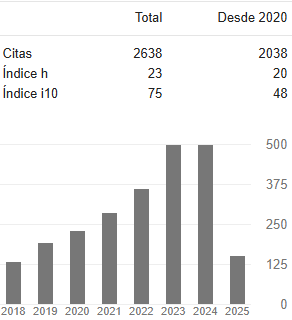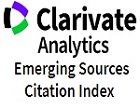Estudio respirométrico de la biodegradación de Diclofenaco
DOI:
https://doi.org/10.31908/19098367.3268Palabras clave:
ompuestos farmacéuticos, degradación biológica, diclofenaco, respirometría, aguas residualesResumen
Los contaminantes pseudo-persistentes presentes en aguas residuales, como los compuestos farmacéuticos, generan la necesidad de estudiar diferentes métodos que sean capaces de degradar dichos contaminantes para reducir su concentración en las fuentes hídricas y en las plantas de tratamiento, ya que podrían producir algunos inconvenientes en las mismas. En este estudio, se lleva a cabo el análisis de la degradación biológica de un antiinflamatorio no-esteroideo, diclofenaco, utilizando técnicas respirométricas. Se realizaron diferentes ensayos en modo batch utilizando un respirómetro tipo LFS (liquid-flowstatic), con lodos activados provenientes de una planta local de tratamiento de aguas residuales, para determinar la biodegradación aerobia del diclofenaco. La concentración inicial de diclofenaco estuvo en el rango de 5-100 mg/L. La degradación fue analizada mediante ensayos de DQO y medidas de OD. El perfil de consumo de OD fue obtenido para todas las muestras. Se obtuvieron remociones cercanas al 50% después de 285 min de reacción. Sin embargo, la degradación biológica aumentó hasta cerca del 80% de remoción del contaminante cuando el tiempo de reacción fue incrementado a 24hs.
Con los resultados obtenidos se pudo establecer que los lodos activados utilizados son capaces de consumir este tipo de contaminante, sin embargo el tiempo de reacción es elevado y, en la mayoría de los casos, superior al requerido en las plantas de tratamiento.
Descargas
Referencias
Kosma, C., Lambropoulou, D., & Albanis, T. (2014). Investigation of PPCPs in wastewater treatment plants in Greece: Occurrence, removal and environmental risk assessment. Science of the Total Environment 466-467, 421-438.
Ashton, D., Hilton, M., & Thomas, K. (2004). Investigating the transport of human pharmaceuticals to streams in the United Kingdom. Science of the Total Environment 333(1), 167-184.
Gómez, M.J., Martínez Bueno, M.J., Lacorte, S., Fernández-Alba, A.R., Agüera, A. (2007). Pilot survey monitoring pharmaceuticals and related compounds in a sewage treatment plant located on the Mediterranean coast. Chemosphere 66(6), 993-1002.
Kraigher, B., Kosjek, T., Heath, E., Kompare, B., & Mandic-Mulec, I. (2008). Influence of pharmaceutical residues on the structure of activated sludge bacterial communities in wastewater treatment bioreactors. Water Research 42(17), 4578-4588.
Carballa, M., Omil, F., Ternes, T., Lema J.M. (2007). Fate of pharmaceutical and personal care products (PPCPs) during anaerobic digestion of sewage sludge. Water Research 41, 2139–2150.
Christensen, F.M. (1998). Pharmaceuticals in the environment—a human risk? Regulatory Toxicology and Pharmacology 28(3), 212–221.
Quintana, J.B., Weiss, S., Reemtsma, T. (2005). Pathways and metabolites of microbial degradation of selected acidic pharmaceutical and their occurrence in municipal wastewater treated by a membrane bioreactor. Water Research 39(12), 2654-2664.
Kosjek, T., Heath, E., Petrovic, M., Barceló, D. (2007). Mass spectrometry for identifying pharmaceutical biotransformation products in the environment. TrAC Trends in Analytical Chemistry 26(11), 1076-1085.
Verlicchi, P., Galletti, A., Petrovic, M., Barceló, D., Al Aukidy, M., & Zambello, E. (2013). Removal of selected pharmaceuticals from domestic wastewater in an activated sludge system followed by a horizontal subsurface flow bed — Analysis of their respective contributions. Science of the Total Environment 454-455, 411-425.
Heberer, T. (2002). Occurrence, fate, and removal of pharmaceutical residues in. Toxicology Letters 131(1-2), 5-17.
Basnyat, P. (2011). Evaluation of toxicity of pharmaceuticals to the activated sludge treatment plant. Master of Science thesis. Tampare University of Technology, 72.
Zhang, Y., Geiben, S-Uwe y Gal, C (2008) Carbamazepine and Diclofenac: removal in wastewater treatment plants and occurrence in water bodies. Chemosphere 23, 1151-1161.
Vieno, N., Sillanpää, M. (2014). Fate of diclofenac in municipal wastewater treatment plant — A review. Environment International 69, 28-39.
Descargas
Publicado
Número
Sección
Licencia
Derechos de autor 2019 Entre Ciencia e Ingeniería

Esta obra está bajo una licencia internacional Creative Commons Atribución-NoComercial 4.0.



















